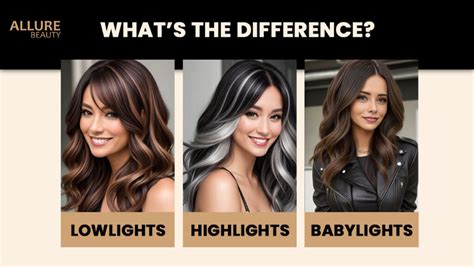Highlights vs. Balayage: An Overview
Highlights and balayage are two popular hair coloring techniques that can add depth, dimension, and style to your look. While both techniques involve lightening strands of hair, they differ in their application, results, and overall effect. Understanding the distinctions between these methods can help you choose the ideal technique to achieve your desired hair transformation.

1. Application Technique
Highlights:
- Uses a traditional foiling or cap technique
- Involves isolating specific strands of hair and applying a lightener to them
- Creates a uniform, more defined look
Balayage:
- Involves a freehand painting method
- The lightener is applied directly to the surface of the hair, creating a feathered, natural-looking effect
- Allows for more subtle, blended transitions
2. Results and Look
Highlights:
- Produces more noticeable, contrasting streaks of lighter hair
- Can create a bold, eye-catching statement
- Ideal for adding volume and brightness
Balayage:
- Delivers a softer, more natural-looking result
- Blends different shades of color seamlessly
- Enhances the hair’s texture and movement
3. Maintenance and Upkeep
Highlights:
- Requires regular touch-ups every 6-8 weeks to maintain the contrast and prevent regrowth
- Can be more time-consuming and expensive to upkeep
Balayage:
- Grows out more subtly over time, reducing the need for frequent touch-ups
- The blending effect helps disguise regrowth
- Generally requires less maintenance and expense
4. Cost and Time Commitment
Highlights:
- Typically more expensive due to the labor-intensive application process
- Can take several hours to complete
Balayage:
- Often more affordable than highlights, especially for long hair
- The freehand painting technique can shorten the application time
Common Mistakes to Avoid
- Over-processing: Excessive lightening can damage hair, leading to breakage and dryness.
- Improper application: Incorrectly applying highlights or balayage can result in uneven or patchy color.
- Insufficient blending: Poor blending can create harsh color transitions and an unnatural appearance.
- Overlapping: Applying the lightener too close to the roots can create an unflattering and difficult-to-blend look.
- Using low-quality products: Using inferior hair color products can compromise the results and damage the hair.
FAQs
- Which technique is best for my hair type?
- Both techniques can work on most hair types. Highlights are particularly suitable for thicker hair, while balayage may be better for finer hair or those seeking a more natural result.
- How often should I get highlights or balayage?
- The frequency depends on your personal preferences and hair growth rate. Highlights typically require more frequent touch-ups (every 6-8 weeks), while balayage can last longer (up to 3-4 months).
- Can I combine highlights and balayage?
- Yes, combining the two techniques can create a unique and eye-catching look. However, it is crucial to consult with a professional stylist to ensure a harmonious blend.
- Is highlights or balayage better for concealing gray hair?
- Highlights can be more effective for fully covering gray roots, while balayage can provide a more subtle, blended effect that disguises gray hair while still maintaining a natural appearance.
- How much do highlights or balayage cost?
- The cost varies depending on the length, density, and condition of your hair, as well as the salon you visit. On average, highlights can cost between $100-$500, while balayage typically ranges from $150-$350.
Conclusion
Whether you choose highlights or balayage, selecting the right technique for your hair and personal style is essential. By understanding the key differences between these methods, you can make an informed decision and achieve the desired hair transformation. Remember to consult with a professional stylist who can provide personalized guidance and ensure a flawless result.
